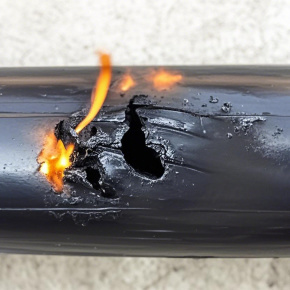
Information
Cable insulation breakdown: Common causes and scientific response strategies
Release time: 2025-03-07
In power systems, cable insulation breakdown is a common and extremely harmful fault. It can cause short circuits, fires, power outages, economic losses, and endanger personal safety. Statistics show that faults caused by it account for 20% of those in power systems. Based on engineering practice and research, this article outlines the causes and solutions for reference.
I. Mechanical Damage: Hidden Hazards of External Force Damage
Causes
Cables are susceptible to mechanical damage from various external forces, leading to insulation breakdown. On construction sites, cable damage from heavy object rolling over, accidental injury during excavation, and excessive bending during transportation and installation are common. Research indicates that when the cable bending radius is less than the allowed value, the probability of insulation layer damage increases by 30%. Directly buried cables subjected to ground strata subsidence can experience tensile forces up to 1000 Newtons, making the insulation layer prone to cracking.
Solutions
-
Optimize Laying Methods: Prioritize overhead cables to reduce mechanical damage risk, with a fault rate 40% lower than directly buried cables. Install protective covers for wall-mounted cables and set warning signs for buried cables. -Standard ize Construction Supervision: Require a soil disturbance permit for factory area excavation, enhance cable vicinity patrols to identify and address 60% of potential hazards, and prohibit unauthorized soil taking.
-
Transportation and Installation Protection: Avoid squeezing and excessive bending during transportation and installation. For oil-impregnated paper insulated cables, control the height difference between ends; for vertically or steeply inclined 6 - 10kV oil-impregnated paper insulated power cables, the height difference should not exceed 15 meters.
II. Construction Process Defects: Link Amplifying Hidden Hazards
Causes
The construction process of cable heads and intermediate joints affects insulation performance. Use of inferior materials, poor sealing, or air bubble retention can reduce insulation. Using epoxy resin before it dries can create partial discharge channels, lowering the inception voltage by 2%0 when air bubbles are present.
Solutions
-
Improve Joint Process: Tighten insulation wrapping and dry epoxy resin and quartz powder to boost insulation by 30%.
-
Enhance Electric Field Distribution: Install grounding shielding rings on high-voltage cable terminations to reduce maximum electric field strength by 30% and even out the electric field.
-
Material Quality Control: Verify cable head sealing during procurement and avoid defective insulation materials to cut insulation breakdown probability by 40%.
III. Insulation Moisture: Water Infiltration Reaction
Causes
Cable sheath corrosion, poor construction sealing, or long-term vibration can allow moisture ingress. Cables near vibration sources have a 50% higher probability of lead sheath cracking, with moisture causing electrochemical corrosion and insulation damage.
Solutions
-
Regular Protective Maintenance: Apply asphalt to the outer sheath every 2 - 3 years and promptly repair damaged sheaths to reduce moisture ingress risk from sheath corrosion by 50%.
-
Improve Sealing Technology: Use double-layer plastic sealing sleeves on cable ends and make sealed joints promptly after laying to lower insulation moisture risk by 40%.
-
Environment-Adaptive Design: Use moisture-resistant materials like cross-linked polyethylene (XLPE) in humid areas, with a 60% lower water absorption rate than conventional materials.
IV. Overvoltage and Insulation Aging: Cumulative Operational Risks
Causes
-
Overvoltage: Lightning or switching overvoltage can cause local electric field distortion in cables. Lightning overvoltage can increase local electric field strength by over 5 times instantaneously, causing electrical tree discharge and insulation structure damage.
-
Aging and Deterioration: Long-term cable overload or poor heat dissipation raises temperature, accelerating insulation aging. Prolonged overload operation can increase cable temperature by over 20℃, reducing insulation resistance by 30%.
Solutions
-
Install Lightning Protection Devices: Fit lightning arresters to cable terminations to direct lightning overvoltage to the ground, reducing insulation breakdown probability by 70%.
-
Intelligent Monitoring and Early Warning: Online partial discharge detection technology enables real-time monitoring and can detect early insulation defects 30 days in advance.
-
Periodic Preventive Tests: Conduct voltage-withstand tests every 3 years and replace cables with substandard insulation resistance.
V. Other Risk Factors and Comprehensive Protection
-
Temperature Control: Avoid long-term cable overload operation and enhance heat dissipation in high-temperature environments. Reducing cable operating temperature by 10℃ slows insulation aging by 30%.
-
Anti-Chemical Corrosion: Use corrosion-resistant sheathed cables like PVC in chemical plants to reduce chemical corrosion-induced insulation breakdown probability by 60%.
-
Standardized Management: Establish cable life files and standardize laying and operation/maintenance processes to cut cable fault rate by 40%.
Cable insulation breakdown stems from multiple factors, necessitating multi-faceted prevention and control. Through scientific operation/maintenance and technological innovation, the fault rate can be reduced to ensure power system safety.
 oversea@hichain.com.cn
oversea@hichain.com.cn
 +8617328576881
+8617328576881










